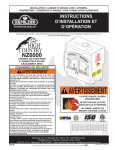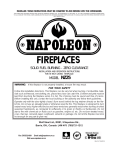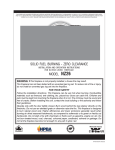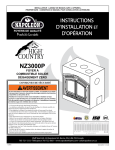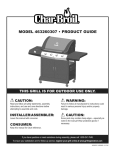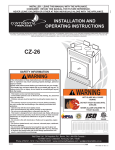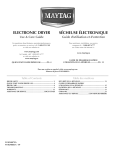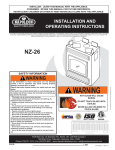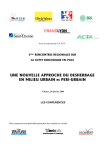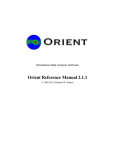Download Napoleon Fireplaces NZ6000 User's Manual
Transcript
1 W415-0442 / C / 09.01.03 W415-0594 / A / 02.15.07 2 WARNINGS & SAFETY PRECAUTIONS W415-0594 / A / 02.15.07 3 TABLE of CONTENTS PG 2-6 INTRODUCTION 7 7-14 14-18 18 19-21 Warnings and safety precautions Warranty General Instructions General Information Care of Glass & Plated Parts 22 23-27 HI-EFFICIENCY HEATING INSTALLATION / FRAMING Location & Clearance Framing Outside Combustion Air Mantel Clearance Hearth Extension Faceplate, Uppergrill, Keystone & Door 27-28 CHIMNEY INSTALLATION Adding Chimney Sections Offset Chimney Installation Installing Flashing And Storm Collar Connection to a Masonry Chimney Air Cooled Chimney Installation FINISHING Attaching the Handle and Air Control Knob Top Firebrick and Baffle Installation BLOWER INSTALLATION 29-30 31 32 BLOWER REPLACEMENT NSK OPTIONAL SCREEN KIT OPERATING INSTRUCTIONS Operating sounds & Smells Starting a Fire Draft Control Fuel Loading and Burn Cycle Re-loading the fireplace Flash Fires Overnight Burn Ash Removal MAINTENANCE Run-Away or Chimney Fire Fire Extinguishers and Smoke Detectors Door Glass / Gasket Replacement Creosote Formation And Removal Selecting Wood REPLACEMENTS Replacement Parts Accessories TROUBLE SHOOTING RATING PLATE LOCATION NZ64 Blower Installation NZ 150-KT Kit PLEASE RETAIN THIS MANUAL FOR FUTURE REFERENCE NOTE: CHANGES, OTHER THAN EDITORIAL, ARE DENOTED BY A VERTICAL LINE IN THE MARGIN. W415-0594 / A / 02.15.07 4 NAPOLEON products are manufactured under the strict Standard of the World Recognized ISO 9001 : 2000 Quality Assurance Certificate. NAPOLEON products are designed with superior components and materials, assembled by trained craftsmen who take great pride in their work. The complete fireplace is thoroughly inspected by a qualified technician before packaging to ensure that you, the customer, receives the quality product that you expect from NAPOLEON. NAPOLEON WOOD FIREPLACE PRESIDENT'S LIFETIME LIMITED WARRANTY The following materials and workmanship in your new NAPOLEON wood fireplace are warranted against defects for as long as you own the fireplace. This covers: combustion chamber, heat exchanger, stainless steel baffle retainer, ceramic glass (thermal breakage only), gold plated parts against tarnishing, porcelainized enamelled components, aluminum extrusion trims ashdrawer, and cast iron castings. Electrical (110V) components and wearable parts such as blowers, thermal switch, switches, wiring, firebrick and gasketing are covered and NAPOLEON will provide replacement parts free of charge during the first year of the limited warranty. Labour related to warranty repair is covered free of charge during the first year. Repair work, however, requires the prior approval of an authorized company official. Labour costs to the account of NAPOLEON are based on a predetermined rate schedule and any repair work must be done through an authorized NAPOLEON dealer. CONDITIONS AND LIMITATIONS NAPOLEON warrants its products against manufacturing defects to the original purchaser only -- i.e., the individual or legal entity (registered customer) whose name appears on the warranty registration card filed with NAPOLEON -- provided that the purchase was made through an authorized NAPOLEON dealer and is subject to the following conditions and limitations: This factory warranty is non-transferable and may not be extended whatsoever by any of our representatives. The wood fireplace must be installed by an authorized service technician or contractor. Installation must be done in accordance with the installation instructions included with the product and all local and national building and fire codes. This limited warranty does not cover damages caused by misuse, lack of maintenance, accident, alterations, abuse or neglect and parts installed from other manufacturers will nullify this warranty. This limited warranty further does not cover any scratches, dents, corrosion or discolouring caused by excessive heat, abrasive and chemical cleaners nor chipping on porcelain enamel parts, nor any venting components used in the installation of the fireplace. In the first year only, this warranty extends to the repair or replacement of warranted parts which are defective in material or workmanship provided that the product has been operated in accordance with the operation instructions and under normal conditions. After the first year, with respect to the President's Limited Lifetime Warranty, NAPOLEON may, at its discretion, fully discharge all obligations with respect to this warranty by refunding to the original warranted purchaser the wholesale price of any warranted but defective part(s). After the first year, NAPOLEON will not be responsible for installation, labour or any other costs or expenses related to the reinstallation of a warranted part, and such expenses are not covered by this warranty. Notwithstanding any provisions contained in the President's Limited Lifetime Warranty, NAPOLEON’S responsibility under this warranty is defined as above and it shall not in any event extend to any incidental, consequential or indirect damages. This warranty defines the obligations and liability of NAPOLEON with respect to the NAPOLEON wood fireplace and any other warranties expressed or implied with respect to this product, its components or accessories are excluded. NAPOLEON neither assumes, nor authorizes any third party to assume, on its behalf, any other liabilities with respect to the sale of this product. NAPOLEON will not be responsible for: over-firing, downdrafts, spillage caused by environmental conditions such as rooftops, buildings, nearby trees, hills, mountains, inadequate vents or ventilation, excessive venting configurations, insufficient makeup air, or negative air pressures which may or may not be caused by mechanical systems such as exhaust fans, furnaces, clothes dryers, etc. Any damages to fireplace, combustion chamber, heat exchanger, brass trim or other component due to water, weather damage, long periods of dampness, condensation, damaging chemicals or cleaners will not be the responsibility of NAPOLEON. The bill of sale or copy will be required together with a serial number and a model number when making any warranty claims from your authorized dealer. The warranty registration card must be returned within fourteen days to register the warranty. NAPOLEON reserves the right to have its representative inspect any product or part thereof prior to honouring any warranty claim. ALL SPECIFICATIONS AND DESIGNS ARE SUBJECT TO CHANGE WITHOUT PRIOR NOTICE DUE TO ON-GOING PRODUCT IMPROVEMENTS. NAPOLEON® IS A REGISTERED TRADEMARK OF WOLF STEEL LTD. PATENTS U.S. 5.303.693.801 - CAN. 2.073.411, 2.082.915. © WOLF STEEL LTD. W415-0594 / A / 02.15.07 5 INTRODUCTION GENERAL INSTRUCTIONS 1. Combustion and dilution air is brought into the unit through the fresh air intake collars located on the top rear of the unit. 4. A single air control regulates the burn rate. 2. The combustion air is brought into the firebox through many small holes in the airwash located at the top and sides of the opening. 6. The optional blower can be installed to draw fresh outside air into the home (not recommended in colder climates), then either the NZ150-KT kit or the NZ64 blower can be installed inside and will circulate the air into your home. 3. The dilution air is introduced high in the firebox above the baffle to cool the chimney. 5. Inside the firebox combustion takes place and exhausts out the chimney. W415-0594 / A / 02.15.07 6 GENERAL INFORMATION FEATURES • Maximum log length of 32" • Large firebox capacity - 4.8 cu ft. • Long burn time - up to 14 hours. • Large glass doors for maximum visibility • Firebrick lining for firebox protection • Optional 320 CFM blower for convection heat • Thermostat for automatic control of the blower • Outside air for combustion HEATING SPECIFICATIONS Approximate Heating Capacity up to 3,000 square feet (Will vary with the home's floor plan, insulation and outside temperature.) Maximum burning time up to 14 hours BTU Output per hour 10,000 to 80,000 (Cord wood method) ELECTRICAL SPECIFICATIONS The blower on "HIGH" draws 2.2 amps on 120 volts A.C. (approximately 250 watts). PACKING LIST Shipped with the fireplace: Installation manual Baffle Ember strip Log retainer Flex duct w/ start collar 10' length, 6" dia (1 for NZ150-KT or blower kit and 2 for outside combustion air supplies). Shipped with faceplate: faceplate 12 faceplate screws Shipped with the door(s): Installation instuctions and hardware EPA COMPLIANCE This heater has been certified epa exempt. W415-0594 / A / 02.15.07 CALIFORNIA PROP 65 WARNING: Use of this product may produce smoke which contains chemicals known to the State of California to cause cancer, birth defects, or other reproductive harm. Do not use makeshift compromises during installation. Do not block or restrict air, grille or louvre openings! Do not add a hood. Burning your unit with door open or ajar creates a fire hazard that may result in a house and/or chimney fire. All venting connections must be in compliance with the chimney manufacturers installation instructions. Clearances referred to throughout this manual are the minimum requirements. Your Napoleon fireplace must be installed in accordance with all national and local building code standards and the standard of Chimney and Fireplaces, Vents and Solid Fuel Burning Appliances NFPA #211. Consult the authority having jurisdiction (such as municipal building department, fire department, fire prevention bureau, etc.) to determine the need to obtain a permit. If you are in doubt about the proper installation for your situation, contact your dealer or local building or fire official. The manufacturer does not guarantee that this fireplace and its options will completely heat your entire home. Expansion / contraction noises during heating up and cooling down cycles are normal and to be expected. It is recommended that in all cases, the fireplace be secured to the floor. Use the pallet packing brackets to accomplish this. CARE OF GLASS, AND PLATED PARTS If the glass is not kept clean permanent discolouration and / or blemishes may result. Normally a hot fire will clean the glass. The most common reasons for dirty glass include: not using sufficient fuel to get the stove thoroughly hot, using green or wet wood, closing the draft so far that there is insufficient air for complete combustion. If it is necessary to clean the glass, use a soft cloth with a non-abrasive cleaner. Do not clean the glass when hot! The glass is very strong but do not let burning fuel rest or fall against it and always close the door gently. Never force it shut! If the glass should ever crack while the fire is burning, do not open the door until the fire is out and do not operate the stove again until the glass has been replaced with a new 5mm thick piece of ceramic glass, available from your Napoleon / Wolf Steel Ltd. dealer. Do not substitute materials. For information on glass removal and replacement, see Maintenance. Do not use abrasive cleaners to clean plated parts. Buff lightly with a clean dry cloth. 7 HI-EFFICIENCY HEATING A HOT AIR GRAVITY VENT SYSTEM (NZ221) may be used to distribute heat to an adjoining room (located either above, or beside the room containing the fireplace) by way of vents. Air flow through this vent must be experimented with and the dampers of the grill adjusted manually to suit your requirements. This may take a few attempts; thereafter adjustments should no longer be required as is normally experienced with your central heating system registers. The hot air vent must be installed in an upward direction! NEVER install in a downward direction. The hot air gravity vent system is not to be connected to a central heating system. No more than two hot air gravity vents may be connected to the fireplace. Individual vent runs are not to exceed 10 feet. All hot air gravity vents must be insulated. INSTALLATION / FRAMING 49 1/2" 24" 51 1/2" 6 5/8" 43" 50 1/4" 10 3/4" 6 1/2" 30 3/4" 8" 29 / " 27 1/2" 12 WARNING: WARNING: COMBUSTION AIR ONLY BLOWER CONNECTION ONLY AVERTISSEMENT: AIR COMBURANT SEULEMENT AVERTISSEMENT: CONNEXION DE LA SOUFFLERIE SEULEMENT 15" 24 3/4" 4 3/8" 19 3/8" 25 3/16" 41" 48 5/8" 30 3/4" 87" 50" 61 1/2" 1 2 " 50 / " 61 3" 12 30 3/4" 50" 61 1/2" 21" MIN When framing in unit, allow ffor or ffinishing inishing ma terial thic kness material thickness kness.. 2 layers of 1/2" cement board needed to fill gap A. W415-0594 / A / 02.15.07 8 LOCATION AND CLEARANCES The fireplace is shipped with a set-up face that is 1/8" larger on the top, bottom and each side than the faceplate. Leave the set-up face in place to act as a template when installing the finishing face. Do not build shelves or cupboards into the area above the fireplace. MAINT AIN THESE MINIMUM CLEARANCES T O MAINTAIN TO COMBUSTIBLES: Framed enclosure Rear - 0" to stand-offs (rear) Sides - 6" to sides* Ceiling - 120" from the base of the unit (enclosure) (unless shielded with metal studs and cement board). Ceiling - 84" from the base of the unit (in front of fireplace) Chimney - 2" (follow manufacturers instructions) - 1" Hot Air Gravity Ductwork Insulation This enclosure must provide greater clearance if air intake vents are run vertical along side the fireplace. SOLID P A CK CHIMNEY PA Ceiling - 120" from the base of the unit (enclosure) (unless shielded with metal studs and cement board). AIR COOLED Ceiling - 84" from the base of the unit (enclosure) We recommend that the fireplace be secured to the floor in all cases. Using the door opening as a datum, level the fireplaceby shimming underneath the fireplace. Remove and discard the lifting handles. Bend the tabs down and secure the unit to the floor. Note: In order to avoid the possibility of exposed insulation or vapour barrier coming in contact with the fireplace body, it is recommended that the walls of the fireplace enclosure be “finished” (ie: drywall/sheetrock), as you would finish any other outside wall of a home. This will ensure that clearance to combustibles is maintained within the cavity. Objects placed in front of the fireplace must be kept a minimum of 48" away from the front face of the unit. IMPORTANT This unit, fully dressed, weighs 850 lbs (385.6kg) Ensure there is adequate floor support for the unit, chimney and facing material. Some material could weigh thousands of pounds. W415-0594 / A / 02.15.07 The fireplace enclosure must be provided with sufficient air circulation to avoid a fire hazard. Install ventilation grilles (minimum openings of 40 sq. inches) at both floor and ceiling levels of the enclosure. These grilles must not restrict the flow of heat by more than 25%. Do not install into any area having a height less than 7 feet (ceiling of enclosure to fireplace bottom, excluding hearth height). The location of windows, doors and the traffic flow in the room where the stove is to be located should be considered. If possible, you should choose a location where the chimney will pass through the house without cutting a floor or roof joist. 9 WHEN USING A SOLID PACK CHIMNEY The fireplace face and enclosure ceiling must be framed using 2x4 metal studs. The minimum enclosure ceiling height is 7 feet. Non-combustible materials (cement board and metal studs) must be used. WHEN USING AN AIR COOLED CHIMNEY W415-0594 / A / 02.15.07 10 OUTSIDE COMBUSTION AIR The duct terminations must be located so they can not be blocked (i.e. snowdrifts). 4' above grade is recommended. Make a 6 ½" inch hole to suit in an outside wall of the house. From outside, place the fresh air hood into the hole, open side down. Seal with caulking and secure. Note: Incorporate a vertical loop or trap into air liners to reduce air flow when unit is not in use. MANTLE CLEARANCES An optional combustible mantle must be a minimum of 12" above the top of the faceplate and not to extend more than 2" from the surface. See chart below for further information. Insulating the intake liners is recommended in colder climates to prevent condensation from occuring. The Napoleon Model NZ6000 takes outside air directly into the fireplace through the openings in the left and right hand sides. Decide on the most convenient location for the fresh air inlet ducts and hoods which may be installed above or below floor level. The fresh air inlet ducts and hoods must be installed. Secure and seal the intake liners to the collars using 3 sheet metal screws, and high temperature sealant. Vertical rise is between: Horizontal run may be: 6' & 10' max 3' & 6' 1' & 3' 0' & 1' 5' 15' 20' 25' Included with the fireplace are: - two 10' lengths of vent. Use a connector and seal if adding more length. - two of intake hoods. The vertical height of the air intake liner must not be greater than 2/3 the height of the chimney. If additional liner length is required, it may be doubled by increasing the size from 6" diameter to 8" diameter. Use a 6" to 8" increaser at the hood and a decreaser at the fireplace. Values in brackets represent 8" diameter intake liners. W415-0594 / A / 02.15.07 11 HEARTH EXTENSION An acceptable 61½" x 20" non-combustible (ie: brick, stone or ceramic tile) hearth extension must be installed. Hearth must extend 20" in front of the faceplate when it is not elevated (see local building codes). Hearth must extend a minimum of 6" to both sides of the unit (61 ½"). Hearth must be a minimum of 1" thick cement board (or equivalent) plus ¼" ceramic tile. Ensure that the gap between the fireplace and a combustible hearth extension is sealed with sand/cement grout or covered with a metal strip (or both) to prevent sparks and embers from falling into this area. Elevated hearths must be constructed of noncombustible materials such as cement blocks or bric k s. brick While the fireplace can be installed directly on the floor, a non-combustible hearth extension is required in front of the fireplace, that must not be built higher than the bottom of the fireplace faceplate. It may therefore be advisable to build the fireplace on a raised platform. Hearths raised minimum 6 ½" must extend a minimum of 18". See hearth examples. W415-0594 / A / 02.15.07 12 HEARTH EXAMPLES ELEVATED HEARTH RAISED HEARTH ELEVATED / RAISED HEARTH W415-0594 / A / 02.15.07 13 FACE PLATE, UPPER GRILL, KEYSTONE & DOOR INSTALLATION 1 4 Remove the facing template held in place with the 12 screws shown. Discard the screws and template. Right Door Handle (operating) - Insert the door rod through the round hole of the latch ensuring the flat edge of the “D” shaped hole points towards the hinges. - Slide the end of the door rod through the bushing at the top of the door as shown. - Insert the handle shaft through the door and the latch. -Secure with 2 flat washers and a nut. See Note #1 - Feed the handle through the handle spacer and into t h e handle shaft. 2 Mount the keystone and upper grill to the faceplate, as shown, using the 4 nuts supplied. Left Door Handle (fixed) Remove the backing and place logo onto the bottom left corner of the faceplate. Ensure that the pressure switch actuating arm and air control rod, protrude through the faceplate when installed. Remember to record your serial # in the manual for future quick reference. 3 Secure the faceplate to the unit, using the 12 screws supplied. Start all 12 screws, then tighten evenly. - Insert the handle shaft through the door. - Secure with a lock washer, 2 flat washers and a nut. - Feed the handle through the handle spacer and into the handle shaft. See Note #2 Note #1: You may need to move washers to the other side of the latch to obtain sufficient door seal. Note #2: The final angle of the left door handle should mirror the right door handle in the closed position. Tighten the nut to secure the left handle at the desired angle. W415-0594 / A / 02.15.07 14 Place brass washers onto the faceplate hinge bushing (2 extra washers are supplied in order to level the doors if needed). 5 6 Install the air c o n t r o l threaded rod and knob. Slide the door hinge pin into the faceplate hinge bushing. To remove the doors, open them slightly and lift them out of the faceplate hinge bushings. CHIMNEY INSTALLATION A raised hearth together with the fireplace built on a raised platform is recommended for easier wood loading and fire viewing. The diameter of the chimney is 8". A chimney venting the fireplace shall not vent any other appliance. The minimum overall chimney height from the top of the fireplace is 15 feet. The maximum overall chimney height from the top of the fireplace is 34 feet. Factory-built chimney systems for use in dwellings constructed for three or more families must be enclosed above the room in which the fireplace is located. This enclosure must have a fire resistance rating equal to or greater than that of the floor or roof assembly through which they pass. If the chimney system is enclosed within the attic area, a rafter radiation shield is required. The chimney should not be built with an offset angle in excess of 45° in Canada and 30° in USA. The chimney must extend at least 3 feet above its point of contact with the roof and at least 2 feet higher than any wall, roof or building within 10 feet. W415-0594 / A / 02.15.07 If the chimney extends more than 5 feet above the roof, it must be secured using a roof brace or guide wires. Ensure that minimum clearances are maintained. Portions of the chimney that extend through accessible spaces must always be encased to avoid personal contact with the chimney and thereby avoid damage to the chimney. A raincap must be installed to avoid internal damage and corrosion. The chimney must be supported at a maximum of 20 foot intervals (approx. 200 lbs/20 ft). This fireplace was tested to CAN /ULC S610 Standard for Factory Built Fireplaces, and to UL 127 Factory Built Fireplaces. This Factory Built Fireplace is certified to burn Fire Wood. The Factory Built Fireplace model: NZ6000 has met test criteria for Zero Clearance Installation to Combustible Surfaces. Any 8" diameter chimney listed to these standards may be installed. In accordance with these standards, the unit may also be connected to any chimney listed to CAN/ULC-S604 and CAN/ULC-S629 for Canada or UL-103HT for the United States. Installation of all types of factory-built chimney systems is to be in accordance with the chimney manufacturers installation instructions. An appropriate chimney manufacturers anchor base plate and anchor base plate gasket is required in order to initiate their system. Use the high temperature gasket, supplied, to seal between the anchor plate and the fireplace top. Air cooled chimney systems are not recommended in colder climates. 15 STRAIGHT UP No Off-Set. Minimum overall chimney height is 15 feet. 2 ELBOWS 4 ELBOWS Single off-set with two 15°, 30° or 45° elbows. Minimum overall chimney height is 15 feet. Double off-set with four 15°, 30° or 45° elbows. Minimum overall chimney height is 15 feet. * The first flue offset closest to the top of the unit must be a minimum distance of 12 inches from the top of the fireplace. 1. Move the fireplace into position. Try to center the exhaust flue of the fireplace, midpoint between two joists to prevent having to cut them. Use a plumb bob to line up the centre. 2. Cut and frame an opening in the ceiling to provide a minimum clearance of 2" between the outside of the chimney and any combustible material. DO NOT FILL THIS SPACE WITH ANY TYPE OF MATERIAL! Nail headers between the joists for extra support. Firestop spacers must be placed on each framed opening in any floor or ceiling that the chimney passes through. 3. Hold a plumb bob from the underside of the roof to determine where the opening in the roof should be. Cut and frame the roof opening maintaining proper 2" clearances. NOTE: 30° or 45° offsets may be installed back to back. ADDING CHIMNEY SECTIONS Add chimney sections, securely, to the required height. Use a rafter radiation shield whenever the chimney system is enclosed within an attic area. - Chimney must extend 3' above the roof. - Chimney must extend 2' above any portion of the roof within 10' of the chimney. W415-0594 / A / 02.15.07 16 OFFSET CHIMNEY INSTALLATION The first flue offset closest to the top of the unit must be a minimum distance of 12" from the top of the fireplace. Attach an elbow to the chimney section, angled toward the offset. Secure with 3 - #8X1/2" sheet metal screws. To achieve the minimum offset, attach and secure a second elbow. To achieve longer offsets, you may install any available length of chimney pipe between the elbows to a maximum length of 4'. Supports must be used on the first vertical chimney section after a return elbow. W415-0594 / A / 02.15.07 INSTALLING FLASHING AND STORM COLLAR Remove the nails from the shingles above and to the sides of the chimney. Place the flashing over the chimney pipe and slide underneath the sides and upper edge of the shingles. Ensure that the chimney pipe is properly centered within the flashing, giving a 3/4" margin all around. Fasten to the roof on the top and sides. DO NOT NAIL through the lower portion of the flashing. Make weather-tight by sealing with caulking. Where possible, cover the sides and top edges of the flashing with roofing material. Apply waterproof caulking, provided with the flashing, around the chimney, 1" above the top of the flashing and push the storm collar down into the caulking. Insert a rain cap onto the top of the last chimney section. 17 CONNECTION TO A MASONRY CHIMNEY The Napoleon Model NZ6000 may be connected to either a lined or unlined masonry chimney. IF THE CHIMNEY IS LINED, the flues must be made of vitrified clay and be in sizes of 8" square or 8" round (inside diameters) or 8"x12" with a minimum height of 15 feet above the fireplace. Eight inch round flues are recommended. Installation must conform to both national and local code requirements. IF THE CHIMNEY IS UNLINED, a stainless steel liner listed to either Standard ULC-S640M in Canada or UL1777 in the USA: Liners for New Masonry Chimneys, may be used to connect the fireplace to the chimney. The liner must be continuous from the fireplace to the chimney cap and be installed only per manufacturers instructions. In both cases, the chimney structure must be supported by angle iron anchored into the masonry walls. The allowable masonry used in chimney construction is 3-1/2" brick, solidly mortared and fully encasing the flue. Ensure there are no leaks. In no case is the masonry enclosure to be supported by the NZ6000 fireplace. Allow a 1" (one inch) air cavity for expansion. ANCHOR PLATE HI-TEMP GASKET FIREPLACE TOP FLUE TILE SUPPORT FOR A MASONRY FIREPLACE FIREPLACE TOP For a masonry fireplace use a flue tile support. For a prefabricated chimney use an anchor plate. W415-0594 / A / 02.15.07 18 AIR COOLED CHIMNEY INSTALLATION 1. Remove the knock out. 2. Cut away the insulation to gain access to the ring. 3. Remove the ring secured by four screws. 4. Slide the starter collar through the insulation wrap and affix using the four screws removed in step 3. 5. Secure the inner liner of the chimney to the fireplace 8" collar using 3 screws supplied with the starter collar (W1700098). 6. Follow the chimney manufacturer's instructions for installing the chimney. AIR COOLED CHIMNEY REQUIREMENTS Use only the ffollowing ollowing br himne y. brand chimne himney and and type of c Chimney Components FMI 8DM 12" Chimney Section 12-8DM 18" Chimney Section 18-8DM 24" Chimney Section 24-8DM 36" Chimney Section 36-8DM 48" Chimney Section 48-8DM Offsets 30E-8DM Flashing 6F 8 or 12F 8 Chimney Cap RTL-8HT Roof Support 38 RS Firestop FS-8DM Chimney Components Wolf Steel Starter Collar NZAC-KT FINISHING ATTACHING THE HANDLE AND AIR CONTOL KNOB The door latch is adjusted by moving the washer from one side of the latch to the other. Tighten the outer nut to secure the latch. Install the air control threaded rod and knob. W415-0594 / A / 02.15.07 19 SECONDARY AIR TUBE REMOVAL / INSTALLATION FIREBRICK AND BAFFLE INSTALLATION OPTIONAL NZ64 BLOWER KIT INSTALLATION Route a 120 Volt, 60Hz electrical supply (not supplied) from the electrical box on the side of the unit to the electrical box on the blower housing. The unit comes complete with a safety switch and a thermally activated switch. For complete instructions, see blower kit. W415-0594 / A / 02.15.07 20 NZ64 BLOWER INSTALLATION This unit is supplied with a pressure switch and a thermally activated switch. Ensure that the pressure switch actuating arm protrudes through the faceplate when installed. The blower will only operate when the doors are fully closed. 3. Connect the 6” collar to the blower opening located on the side of the unit. An optional opening is covered on the other side of the unit. If this location is preferred, switch the cover plate and collar. Secure by reaching through the collar and bending the tabs. Use sealant to ensure that the connection is air tight. 1. Remove the template. 2. Position the blower to an inside or outside wall into a framed opening 12 3/8” wide by 10 1/2” high. (Outside wall not recommended in colder climates as cold air may be drawn into the house when the fireplace is off.) The blower housing should be installed onto a level surface large enough to support the blower assembly y.. Allow for finishing material when securing the blower housing, as the grill mounts to the housing. We recommend installing the blower in a different room or even different level of the house. This will generate greater air movement and improve the distribution of the warm air coming from the fireplace. W415-0594 / A / 02.15.07 21 4. Electrical Connection a) Remove the junction box covers on the unit and the blower. 5. Connect the 6” liner to the unit and blower collars. Secure using 3 screws on each end and seal with caulking. Liner supplied stretches to a maximum of 10’. b) Removing the junction box cover on the unit exposes 4 black, labeled wires: Two wires labelled "by-pass" - go to by-pass (summer) switch (not supplied - overides the thermally activated switch enabling the user to run the blower without heat). Important: Marrett by-pass (summer) switch wire leads separately (do not connect together), if the by-pass switch is not desired. One wire labelled "blower" - connects to KB-35 rheostat (not supplied) and then KB-35 blower wire connects to white blower wire. One wire labelled "L1" - connects to power (hot lead). c) Removing the junction box cover on the blower exposes 3 coloured wires: One black wire - connects to power "L2" (neutral lead). One green wire - connects to ground. One white wire - connects to KB-35 rheostat (not supplied) See above. 6. Insert the filter into the grill. Foam gasket (1/2” weather stripping) between the grill and blower housing is recommended, but not supplied. The blower filter is washable. 7. The bottom lip of the grill latches over the bottom lip of the housing. Use two screws to secure the top of the grill to the facing. NZ150-KT KIT The circulation air inlet pipe must terminate outside of the fireplace enclosure to ensure proper air flow around the firebox. The 6" circulation air inlet pipe may be connected to either the NZ64 blower kit or the NZ150-KT kit. Avoid terminating higher than the bottom of the doors on the unit to prevent air flow reversal. An optional opening is covered on the other side of the unit. If this location is preferred, switch the cover plate andW415-0594 collar. / A / 02.15.07 22 NZ64 BLOWER REPLACEMENT 4. Slide the bracket and blower out of the housing. 5. Disconnect the wire connector from the blower. 1. Remove the grill and filter by removing the 2 securing screws. 6. Remove the old blower from the bracket by removing the four screws. 2. Remove the nut securing the blower bracket to the housing. 7. Secure the new blower to the existing bracket using the four screws removed in step 6. 8. Slide the new blower/bracket assembly into the housing. Ensure that the blower bracket slides into the clips at the back of the housing on either side. 9. Push the assembly into the housing as far in as possible. 10. Secure the assembly to the housing using the nut removed in step 2. 11. Re-secure the grill by replacing the 2 securing screws. 3. Lift the handles to pull the blower and bracket off of the stud. NSK OPTIONAL SCREEN KIT Use the screen when you are in the room to enjoy the ambience of an open, w ac kling ffir ir wood crac ack ire ood cr e. Medium sized wood loads should be used to prevent logs from rolling against the screen. W415-0594 / A / 02.15.07 Chimney action may not allow the screen to be used in some installations due to the resulting smok smoke spillag by-pass e spilla g e. Opening the b y-pass damper ma y help pr e v ent smok e spilla ge. W ood will may pre smoke spillag Wood burn at a faster rate and heat output will be less with the screen compared to the stove operation with the glass doors closed. 23 OPERATING INSTRUCTIONS Expansion / contraction noises during heating up and cooling down cycles are normal and to be be expected. OPERATING SOUNDS AND SMELLS A slight humming sound may be heard depending on the location of the blower. This sound may be minimized by turning down the blower. When first installed, the fireplace and the steel are cold and must become hot before the fireplace will function well. During the break-in period (the first 2 or 3 fires) create only small, hot fires using kindling; this will allow the firebrick to cure. Do not be alarmed if small hairline cracks develop in the firebrick. This is a normal occurrence and does not pose a safety hazard. The paint may also smell a little for the first few fires as it cures and you may wish to open a door or window to alleviate the smell. There are many different ways to start a fire, review the hints and warnings in this section to ensure the fire is started properly. STARTING A FIRE Make sure the air control is on high (far right position). You may also open the doors 1" to 2" during the first five minutes of start-up, if additional air is needed. Opening the by-pass damper will help heat up the chimney more quickly. If desired close after draft is established. Never use gasoline, gasoline-type lantern fuel, kerosene, charcoal lighter fluid, or similar liquids to start or freshenup a fire in this fireplace. Keep all such liquids well away from the fireplace while it is in use. If using a firestarter, use only products specifically designed for fireplaces - follow the manufacturer's instructions carefully. Use plenty of newspaper and kindling to ensure the fireplace reaches a proper temperature. Once the kindling is burning rapidly, place a few larger pieces of wood onto the fire. Tip: When first lighting a fire, if the smoke is not quickly drawn into the chimney, there may be a downdraft or cold air in the chimney. Roll up some newspaper, light it and place it near the fireplace flue until the chimney begins to draw. When a fire is burning, open the door slowly to avoid drawing smoke into the room. A properly installed Napoleon fireplace should not smoke. If yours does, check the following: Has the chimney had time to get hot? Are the air intake hoods blocked closed? Is the smoke passage blocked anywhere in the fireplace or chimney? Is the smoke flow impeded by too long a horizontal pipe or too many bends? Is it a weak draft perhaps caused by a leaky chimney, a cold outside chimney, too short a chimney, or a chimney too close to trees or a higher roof? DRAFT CONTROL Draft is the force which moves air from the fireplace up through the chimney. The amount of draft in your chimney depends on the length of the chimney, local geography, nearby obstructions and other forces. Adjusting the draft control regulates the temperature. The draft can be adjusted from a low burn rate with the air control on the low setting to a fast burn rate with the air control on the high setting (far right position). Inadequate draft may cause back-puffing into the room and may cause plugging of the chimney. Too much draft may cause an excessive temperature in the fireplace, glowing red fireplace parts or an uncontrollable burn which can all lead to a chimney fire or a permanent damage to the unit. Remove all source of gasoline or other flammable vapours and liquids in the vicinity of this or other appliances prior to lighting. 1. To start, a brisk fire is required. Place loosely crumpled paper on the floor of the fireplace behind the log retainer. W415-0594 / A / 02.15.07 24 2. Cover with dry kindling. 5. To maintain a brisk fire, a hot coal bed must be established and maintained. 3.Open the draft control fully by moving the lever to the right (HIGH setting). 6. Slowly add larger wood (2x4 size pieces). Lay the pieces lengthwise from side to side in the hot coal bed with a shallow trench between, so that the primary air can flow directly into this trench and ignite the fuel above. 7. When the fire seems to be at its peak, medium sized logs may be added. Once these logs have caught fire, carefully close the door. Closing the door too quickly after refueling will reduce the firebox temperature and may result in an unsatisfactory burn. 4. Light the paper and leave the door slightly ajar (one to two inches) until all kindling is burning. W415-0594 / A / 02.15.07 25 As soon as the door is closed, you will observe a change in the flame pattern. The flames will get smaller and lazier because less oxygen is getting into the combustion chamber. The flames, however, are more efficient. The flames will remain lazy but become larger again as soon as the firebricks have been heated thoroughly and the chimney becomes heated and provides a good draft. Can't get the fireplace operating? Use more kindling and paper. Assuming the chimney and vent are sized correctly and there is sufficient combustion air, the lack of sufficiently dry quantities of small kindling is the problem. Thumb size is a good gauge for small kindling diameter. Can't get heat out of the fireplace? One of two things may have happened. The fireplace door may have been closed prematurely and the fireplace itself has not reached optimum temperature. Re-open the door and/or draft control to re-establish a brisk fire. The other problem may have been wet wood. The typical symptom is sizzling wood and moisture being driven from the wood. FUEL LOADING AND BURN CYCLE The bricks will be nearly all white and the glass mostly clear. The whiteness of the bricks and the cleanness of the glass are good indicators of your operating efficiency. At this point, the roaring fire that you see when the door is opened is wastefully drawing heated room air up the chimney -- certainly not desirable. So always operate with the door fully closed once the medium sized logs have caught fire. You can now add larger pieces of wood and operate the fireplace normally. Once the fireplace is entirely hot, it will burn very efficiently with little smoke from the chimney. There will be a bed of hot coals in the firebox so you can safely fill the firebox with wood to the top of the andirons. Not enough heat is produced when only one or two pieces of wood are burned. A minimum of three pieces are needed to encase a bed of coals that sustains the fire. Loosely stacked wood burns quicker than a tightly packed load. Wood burns in cycles rather than giving a steady output of heat. It is best to plan these cycles around your household routine so that only enough coals are left to start the next load. In the evening, load your fireplace, at least, a halfhour before bed to ensure the fire is hot enough to close the draft control for an overnight burn. Burn only dry seasoned wood. It produces more heat and less soot or creosote. Do not burn ocean beach wood. Its salt content can produce a metal eating acid. W415-0594 / A / 02.15.07 26 RE-LOADING THE FIREPLACE When refueling open the door slowly to prevent smoke spillage. Use a pair of long fireplace gloves when feeding the fire. Keep a small steel shovel nearby to use as a poker and to remove ashes. Do not store wood within 4 feet (1m) of the fireplace. Follow the directions below to minimize smoke spillage while re-loading the fireplace. 1. Move the air control to high. 2. Open the door slightly. Allow the airflow inside the firebox to stabilize before opening the doors fully. 3. Load wood to the top of the cast retainers and burn at a medium low setting. FLASH FIRES A flash fire is a small fire burned quickly when you don't need much heat. After your kindling has "caught", load at least 3 pieces of wood, stacked loosely. Burn with the draft control fully open or closed only slightly. OVERNIGHT BURN This fireplace is large enough to accomodate overnight, 14 hour burns. Follow these steps below to achieve an overnight burn. 1. Get the fireplace hot by moving the air control to high and letting the fireplace burn for 15 minutes. 2. Load your larger pieces of wood compactly, packed close enough to prevent the flames from penetrating it completely. W415-0594 / A / 02.15.07 3. After approximately 30 minutes, depending on the size of the load, close the draft control completely making sure that the fire is not extinguished. 4.In the morning the fireplace should still be hot, with embers in the coal bed. Stir the coals and load small pieces of wood to re-ignite the fire, if desired. Note: Differences in chimney height and draft may lower overall burn times. DO NOT OVERFIRE THE FIREPLACE! Overfiring can occur by: a) burning large amounts of smaller wood pieces. b) vigorously burning large loads of wood with the draft control on "HIGH" (fully open) for long periods of time (one or two hours). ASH REMOVAL PROCEDURES A bed of ashes approximately 1 inch deep should be left on the firebox bottom to help maintain a hot charcoal bed. When the fire has burned down and cooled, remove any excess ashes. To remove the ash, follow the directions below. 1. After the last coal has extinguished, let the fireplace cool at least two hours. 2. Open the fireplace doors. 3. Scoop the ash from the firebox into a metal, airtight, container with a lid. Cover the container with the lid and move the container away from the fireplace to ensure the ashes cool. Dispose of the ashes. Warning: Improper disposal of ashes result in fires. Do not discard ashes in cardboard boxes, dump in back yards, or store in garages. Note: If using a vacuum to clean up ashes, be sure the ashes are entirely cooled. Using a vacuum to clean up warm ashes could cause a fire inside the vacuum. 27 TIPS FOR BURNING • • • • • • Create a large fire to heat up the fireplace before adjusting to a slower burn. To create a large, quick burning fire, use small pieces of wood. For a lower, but extended burn, stack larger pieces of wood close together. For long burns, leave a 1-2" bed of ashes. Burn dry wood only. With the exception of overnight burns, create large, quick burning fires whenever possible. Smaller, slow burning fires, using large logs, cause the glass to become dirty. Larger, quick burning fires using medium sized wood to refuel frequently are much more efficient. MAINTENANCE RUN-AWAY OR CHIMNEY FIRE Run-away fires can be the result of FOUR major factors: 1. Using incorrect fuel, or small fuel pieces which would normally be used as kindling. 2. Leaving the door ajar too long and creating extreme temperatures as the air rushes in the open door. 3. Improperly installed or worn gaskets. SOLUTIONS: 1. Do not burn treated or processed wood, coal, charcoal, coloured paper or cardboard. 2. Be careful not to overfire the unit by leaving the door open too long after the initial start-up. 3. Replace worn, dried out (inflexible) gaskets. WHAT TO DO IF A RUN-AWAY OR CHIMNEY FIRE STARTS: 1. Close the draft fully (lowest position). 2. Call the local fire department. 3. Examine the chimney, attic and roof of the house, to see if any part has become hot enough to catch fire. If necessary spray with a fire extinguisher or water from a garden hose. 4. Do not operate the stove again until you are certain the chimney has not been damaged. FIRE EXTINGUISHERS AND SMOKE DETECTORS All homes with a solid fuel burning fireplace should have at least one fire extinguisher in a central location, known to all, and at least one smoke detector in the room containing the fireplace. If it sounds an alarm, correct the cause but do not de-activate or relocate the smoke detector. GLASS & GASKET REPLACEMENT At the end of each burning season inspect the door gasket ensuring that it is not worn or loose. Replace with proper fibreglass rope. The purpose of door gasketing is to seal the firebox. If the doors are not sealed, air leaks into the firebox, creating a quick burning fire. This situation is not desireable for overnight or extended burns. Replace cracked or broken glass immediately. When reinstalling the glass, be sure that the glass and gasket create a solid seal around door frame. Follow the instructions below for glass removal. You many require a flat tool to gently press the gasket between the glass and the door. WARNING: Make sure that the glass and gasket are fully installed down into the glass retainer. If the glass protrudes too far out of the retainer, the glass will shatter when the door is closed. W415-0594 / A / 02.15.07 28 CREOSOTE FORMATION AND REMOVAL SELECTING WOOD When wood is burned slowly, it produces tar and other organic vapours which combine with expelled moisture to form creosote. These vapours condense in the relatively cooler chimney flue of a slow burning fire and when ignited, make an extremely hot fire. Check your chimney for creosote and soot build-up monthly until a safe frequency for cleaning is established (minimum once a year). If accumulation is excessive, clean the chimney. You may want to call a professional chimney sweep to clean it. Both the chimney and the fireplace have to be cleaned at least once a year or as often as necessary. Burn only dry, clean unpainted wood that has been seasoned. It produces more heat and less soot or creosote. Freshly cut wood contains about 50% moisture while after proper seasoning only about 20% of the water remains. As wood is burned, this water boils off consuming energy that should be used in heating. The wetter the wood, the less heat is given off and the more creosote is produced. Dry firewood has cracks in the end grain. Both hardwood and softwood burn equally well in this fireplace but hardwood, which is denser, will weigh more per cord and burn a little slower and longer. Firewood should be split and stacked in a manner that air can get to all parts of it and covered in early spring to be ready for burning that fall. W415-0594 / A / 02.15.07 29 REPLACEMENTS Contact your dealer for questions concerning prices and policies on replacement parts. Normally all parts can be ordered through your Napoleon dealer or distributor. When ordering replacement parts always give the following information: 1. 2. 3. 4. 5. FOR WARRANTY REPL ACEMENT PAR TS, A PHO TOCOPY OF REPLA ARTS PHOT THE ORIGINAL INVOICE WILL BE REQUIRED TO HONOUR THE CLAIM. FIREPLACE AND ACCESSORY REPLACEMENT PARTS # PART NO. DESCRIPTION 1 2* 3* 4* 5* 6 7 8 9 10 11 12 13* 14* 15 16 17* 18* 19 20 21 22 23* 24* 25* 26* W300-0069 W562-0035 W562-0036 W010-1225 W690-0005 W090-0099 W090-0101 W090-0100 W090-0098 W090-0097 W010-1399 W062-0018 KB35 W690-0002 W010-1184 W010-1183 W200-0141 W555-0047 W380-0017 W010-1193 W010-1180 W325-0029 W175-0002 NZ220-2 W410-0005 W010-0067 27 28 29* 30 31 32 33* W715-0628 W185-0020 W385-0245 W410-0026 W010-1594 W290-0121 W450-0028 DOOR GLASS DOOR OR GLASS GASKET DOOR GASKET - CENTRE GLASS & GASKET 120V THERMOSTAT REAR FIREBRICK BOTTOM RIGHT FIREBRICK BOTTOM LEFT FIREBRICK RIGHT SIDE FIREBRICK LEFT SIDE FIREBRICK BAFFLE BLOWER - NZ64 VARIABLE SPEED CONTROL INCL KNOB HEAT SENSOR LEFT DOOR ASSEMBLY RIGHT DOOR ASSEMBLY PRIMARY AIR PLATE PRIMARY AIR ROD PRIMARY AIR KNOB PRIMARY AIR ACCESS COVER ASH LIP ASSEMBLY DOOR HANDLE - BIRD CAGE 8" COUPLER 5'X8" DIA. AIR VENT (FOR GRAVITY HOT AIR VENT) 10'X8" DIA AIR VENT (FOR CENTRAL HEATING SYSTEM) VENT SUPPORT BRACKET (FOR CENTRAL HEATING SYSTEM ) ANDIRONS GRATE NAPOLEON LOGO 10'X6" AIR SUPPLY VENT SECONDARY AIR TUBE GASKET, SECONDARY AIR TUBE NUT, HEX BRASS MODEL & SERIAL NUMBER OF FIREPLACE INSTALLATION DATE OF FIREPLACE PART NUMBER DESCRIPTION OF PART FINISH * IDENTIFIES ITEMS WHICH ARE NOT ILLUSTRATED. FOR FURTHER INFORMATION, CONTACT YOUR NAPOLEON DEALER. ACCESSORIES # PART NO. DESCRIPTION 34 34 34 34 35 35 35 36 36 36 37 37 37 38 39 40* 41 42 12* 31* 32 33* H335-K H335-G H335-SC H335-WI FPK FPSC FPWI UGK UGG UGSC KSK KSG KSSC NSK CP NZ221 NM228-M NZAC-KT NZ64 W250-0005 W305-0007 NZ150-KT ARCHED DOORS - BLACK ARCHED DOUBLE DOORS - GOLD PLATED ARCHED DOUBLE DOORS - SATIN CHROME FINISH ARCHED DOUBLE DOORS - WROUGHT IRON FINISH FACEPLATE ARCHED - BLACK FACEPLATE ARCHED - SATIN CHROME FINISH FACEPLATE ARCHED - WROUGHT IRON FINISH UPPER GRILL ARCHED - BLACK UPPER GRILL ARCHED - GOLD PLATED UPPER GRILL ARCHED - SATIN CHROME FINISH KEYSTONE - BLACK KEYSTONE - GOLD PLATED KEYSTONE - SATIN CHROME FINISH ARCHED DOUBLE SCREEN KIT WITH STAND CRANE AND POT GRAVITY HOT AIR VENT KIT FLUE TILE SUPPORT AIR COOLED CHIMNEY KIT BLOWER KIT BLOWER FILTER BLOWER GRILL CIRCULATION AIR MOUNTING KIT W415-0594 / A / 02.15.07 30 W415-0594 / A / 02.15.07 31 TROUBLE SHOOTING GUIDE BEFORE ATTEMPTING TO TROUBLESHOOT, PURGE YOUR UNIT AND INITIALLY LIGHT THE PILOT AND THE MAIN BURNER WITH THE GLASS DOOR OPEN. SYMPTOM PROBLEM TEST SOLUTION Smoke enters the Cold air blockage. room during startClose the doors. up. - burn a piece of newspaper to establish a draft. Kindling does not Cold air blockage. start - fire smolders. Not enough starter paper. - burn a piece of newspaper to establish a draft. Not enough air. - if the flame is not getting enough air, first make sure the air control is open. If additional air is needed, open the doors a small crack only. - open the by-pass damper - use additional newspaper if necessary. - first make sure the air control is fully open. If additional air is needed, a small crack in the doors is all that is needed. Smoke enters the Insufficient Draft. room while reloading. - Chimney height and outside conditions can negatively affect draft. In these cases a small amount of smoke may enter the home. Adding more pipe or a draft-inducing cap may help. Fireplace does Wood is wet. not burn hot Insufficient Draft. enough. - see the section on "Selecting Wood" for details. Air control is not wide open. The by-pass damper is in the "open" position Blower does not Fireplace is not up to run. temperature. Faceplate is cold. - Chimney height and outside conditions can negatively affect draft. In these cases a small amount of smoke may enter the home. Adding more pipe or a draft-inducing cap may help. - make sure the air control is open all the way. Slide the control back and forth rapidly to insure the control is not stuck. - close the by-pass damper - this is normal. The blower will come on when the fireplace is hot usually 15 to 30 minutes. Electricity is cut to the blower. - check the household breaker or fuse to make sure it is operable. This is normal. - the air leading into the firebox comes from the exterior. In some cases this air comes into the firebox and exits up the chimney. This will not damage the fireplace. Fireplace does The doors are not sealing. - the doors are not sealing - see the section "Door Glass / Gasket not burn overnight. Replacement" for details. The by-pass damper is in the - close the by-pass damper "open" position W415-0594 / A / 02.15.07 RATING PLATE IS LOCATED BEHIND THE FIREPLACE FACEPLATE. 32 RATING PLATE W415-0594 / A / 02.15.07
































